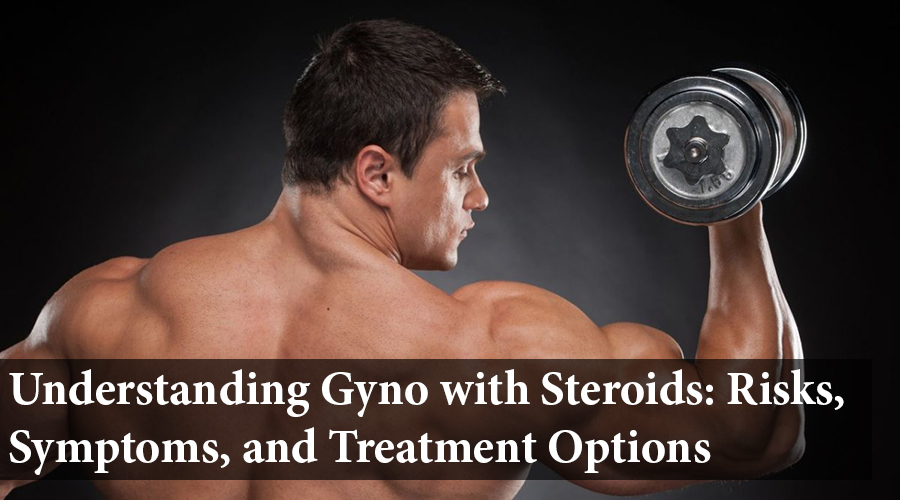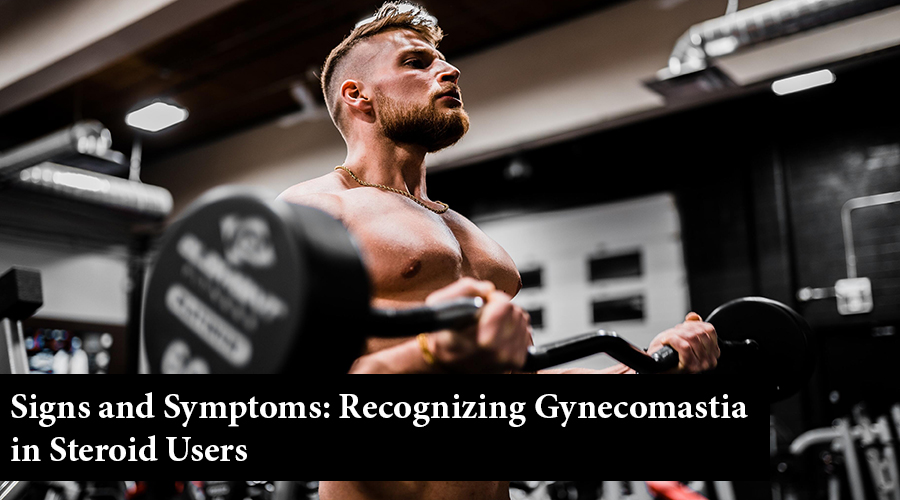Understanding Gyno with Steroids: Risks, Symptoms, and Treatment Options
Gynecomastia, commonly known as "gyno," refers to the enlargement of breast tissue in males. While this condition can occur naturally due to hormonal imbalances, it is also associated with the use of anabolic steroids. The pursuit of a well-sculpted physique has led many individuals to turn to steroids as a means to enhance their muscle growth and athletic performance. However, it is crucial to understand the potential side effects that accompany steroid use, including the development of gynecomastia. In this article, we delve into the intricate relationship between gyno and steroids, exploring its causes, effects, and ways to mitigate the risks involved.
The Mechanism of Gynecomastia: Understanding the Hormonal Interplay
Gynecomastia with steroids involves a complex interplay of hormones within the body. To comprehend the mechanism behind gynecomastia, it's important to delve into the hormonal interplay between testosterone and estrogen.
Testosterone is the primary male sex hormone responsible for the development of male characteristics, including muscle growth, deepening of the voice, and facial hair. It plays a vital role in maintaining hormonal balance. Estrogen, on the other hand, is the primary female sex hormone responsible for the development of female characteristics, including breast growth.
When anabolic steroids are introduced into the body, they increase the levels of synthetic testosterone. This influx of testosterone can lead to an overabundance of androgens, which can aromatize, or convert, into estrogen. Consequently, the estrogen levels can rise, leading to an imbalance between testosterone and estrogen.
Excessive estrogen in the male body can stimulate the breast tissue, causing it to grow and develop. This leads to the characteristic swelling and enlargement of the breast area, which is the hallmark of gynecomastia. The hormonal imbalance disrupts the normal regulatory mechanisms, resulting in the development of gyno with steroids.
It's worth noting that gynecomastia is not solely caused by estrogen; it involves a complex hormonal interplay. Factors such as the individual's genetic predisposition, sensitivity of breast tissue to hormonal changes, and the type and dosage of steroids used can also influence the development of gyno.
Understanding the intricate hormonal interplay involved in gyno with steroids is essential for individuals in Australia who engage in steroid use. By grasping the mechanism behind gynecomastia, individuals can take proactive measures to minimize the risk or seek appropriate treatment options if gyno develops.
Anabolic Steroids and Gyno: Causes and Risk Factors
Anabolic steroids, commonly used by individuals in Australia for performance enhancement, muscle growth, and bodybuilding, can contribute to the development of gynecomastia. Understanding the specific causes and risk factors associated with anabolic steroids can help shed light on why gyno occurs in steroid users.
One of the primary causes of gyno with anabolic steroids is the conversion of excess testosterone into estrogen. Anabolic steroids often contain compounds that have aromatizing properties, meaning they can convert testosterone into estrogen through a process known as aromatization. This increase in estrogen levels can disrupt the hormonal balance and lead to the growth of breast tissue.
Not all anabolic steroids have the same propensity for aromatization. Some steroids, such as testosterone-based compounds like testosterone enanthate or testosterone cypionate, have a higher potential for aromatization compared to others. This makes them more likely to contribute to gyno development. Other factors, such as the dosage and duration of steroid use, can also influence the risk of gyno.
Individuals who are genetically predisposed to gynecomastia may be at a higher risk when using anabolic steroids. Certain individuals have a higher sensitivity of breast tissue to hormonal changes, making them more susceptible to gyno even with lower doses of steroids or shorter durations of use.
It's important to note that gynecomastia is not an immediate or guaranteed side effect of using anabolic steroids. The likelihood of developing gyno varies from person to person and depends on multiple factors, including individual biology, steroid choice, dosage, and duration of use.
Understanding the causes and risk factors associated with anabolic steroids and gyno is crucial for individuals in Australia who are considering or currently using these substances. By being aware of the potential risks, individuals can make informed decisions, monitor their health closely, and take necessary precautions to minimize the likelihood of developing gynecomastia.
Signs and Symptoms: Recognizing Gynecomastia in Steroid Users
Recognizing the signs and symptoms of gynecomastia is crucial for individuals using steroids in Australia. Being aware of the early indications allows for timely intervention and appropriate management. Here are some common signs and symptoms to look out for:
1. Breast Tissue Enlargement: One of the primary signs of gynecomastia is the swelling and enlargement of the breast tissue in males. This can affect one or both breasts and may be accompanied by tenderness or sensitivity.
2. Nipple Changes: Gyno with steroids can cause changes in the nipples. You may notice the nipples becoming more prominent, puffy, or developing a cone-like shape. In some cases, nipple discharge may also occur.
3. Breast Texture: The texture of the affected breast area may change with gynecomastia. It can feel firm, rubbery, or even lumpy upon touch. These changes are distinct from the surrounding muscle tissue.
4. Psychological Impact: Gynecomastia can have a psychological impact on individuals, causing feelings of self-consciousness, body image issues, and emotional distress. It's important to consider the emotional well-being of steroid users and provide support if gyno develops.
5. Other Symptoms: In some cases, gynecomastia may be accompanied by symptoms such as breast pain, itching, or a tingling sensation in the affected area.
If you notice any of these signs or symptoms while using steroids, it's crucial to consult a healthcare professional for an accurate diagnosis. They can evaluate the condition and determine whether it is gynecomastia or another underlying issue.
Early detection of gyno with steroids can lead to more effective treatment options and potentially minimize the impact on physical and psychological well-being. By recognizing the signs and symptoms, individuals in Australia can take proactive steps towards managing gynecomastia and maintaining overall health.
The Psychological Impact: Coping with Gyno and Body Image Issues
Gyno with steroids not only affects the physical appearance of individuals but also has a significant psychological impact. Coping with gynecomastia and the associated body image issues is essential for the overall well-being of individuals in Australia who experience this condition.
Body image concerns are common among individuals with gynecomastia. The physical changes brought about by gyno can lead to feelings of self-consciousness, embarrassment, and a negative impact on self-esteem. It's important to acknowledge that these emotional reactions are valid and understandable.
Seeking support from friends, family, or support groups can provide individuals with a safe space to express their concerns and fears. Connecting with others who have experienced gyno with steroids can be particularly helpful, as they can provide empathy, advice, and coping strategies.
Professional counseling or therapy can also be beneficial for managing the psychological impact of gynecomastia. A mental health professional can help individuals develop coping mechanisms, improve body image, and enhance self-acceptance.
Additionally, adopting a proactive approach to managing gyno can empower individuals and positively impact their mental well-being. Seeking medical advice and exploring treatment options such as medication or surgical interventions can provide individuals with a sense of control and hope for improvement.
It's important to remember that gyno with steroids does not define an individual's worth or identity. Engaging in self-care practices, practicing self-compassion, and focusing on overall health and well-being can help individuals navigate the psychological challenges associated with gynecomastia.
Ultimately, it's essential to prioritize mental health and seek support when coping with gyno and body image issues. Remember, you are not alone, and there are resources available to help you through this journey.
Preventive Measures: Minimizing the Risk of Gynecomastia while using Steroids
While gynecomastia with steroids can occur, there are preventive measures individuals in Australia can take to minimize the risk or severity of this condition. By implementing the following strategies, individuals can prioritize their health and reduce the likelihood of developing gynecomastia:
1. Educate Yourself: Gain a comprehensive understanding of the potential side effects and risks associated with steroid use. Be aware of the specific steroids that have a higher potential for aromatization and gynecomastia development.
2. Follow Proper Dosages: Adhere to recommended steroid dosages and cycles provided by healthcare professionals or experienced experts. Avoid exceeding the suggested limits, as higher dosages can increase the likelihood of gynecomastia.
3. Consider Aromatase Inhibitors: Aromatase inhibitors (AIs) are medications that can help prevent the conversion of testosterone into estrogen. When used alongside anabolic steroids, AIs can help mitigate the risk of gyno development. Consult a healthcare professional for guidance on using AIs safely.
4. Regular Monitoring: Stay vigilant and monitor your body for any early signs or symptoms of gynecomastia. Regularly examine the breast tissue and nipples for changes in size, shape, or sensitivity. Early detection allows for prompt intervention and management.
5. Supportive Supplements: Some supplements, such as Selective Estrogen Receptor Modulators (SERMs), can help regulate estrogen levels and reduce the risk of gyno. Discuss with a healthcare professional to determine if such supplements are appropriate for your individual situation.
6. Hormonal Balance: Focus on maintaining a healthy hormonal balance by adopting a well-rounded lifestyle. This includes regular exercise, a balanced diet rich in nutrients, adequate sleep, and stress management. A healthy lifestyle can support overall hormonal health.
Remember, prevention is key, and being proactive about minimizing the risk of gyno can contribute to a healthier steroid usage experience. It's essential to consult with healthcare professionals or experts in the field for personalized advice tailored to your specific needs and circumstances.
Navigating the Fitness World: Alternative Strategies for Muscle Growth without Steroids
For individuals in Australia who are concerned about the risks associated with steroid use, exploring alternative strategies for muscle growth can provide a safer and more sustainable approach. Here are some alternative methods to consider:
Progressive Resistance Training: Engage in a well-structured progressive resistance training program. Gradually increase the intensity, volume, and load of your workouts over time to stimulate muscle growth naturally.
Nutrition and Balanced Diet: Focus on consuming a balanced diet rich in lean proteins, healthy fats, and complex carbohydrates. Adequate nutrition is crucial for muscle growth and repair.
Supplement Wisely: Explore natural supplements that can support muscle growth and recovery, such as protein powders, creatine, and branched-chain amino acids (BCAAs). However, it's important to research and consult with professionals to ensure the safety and effectiveness of any supplements you consider.
Optimize Rest and Recovery: Allow your body sufficient time to recover between workouts. Proper rest, quality sleep, and stress management are vital for muscle growth and overall well-being.
Seek Professional Guidance: Consult with certified fitness trainers, coaches, or nutritionists who can provide personalized guidance and develop tailored workout and nutrition plans that align with your goals.
Focus on Compound Exercises: Incorporate compound exercises into your training routine, as they engage multiple muscle groups simultaneously. Examples include squats, deadlifts, bench presses, and pull-ups. Compound exercises promote overall muscle development and strength.
Consistency and Patience: Understand that natural muscle growth takes time and consistent effort. Be patient, stay committed to your fitness journey, and celebrate small milestones along the way.
By adopting these alternative strategies, individuals in Australia can achieve significant muscle growth and athletic performance without relying on the use of anabolic steroids. Remember, it's essential to prioritize long-term health, well-being, and sustainability in your fitness pursuits.


0 Comments